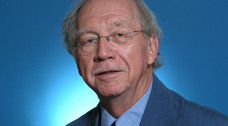05-05-2010

Gaston Harnois, M.D., est au Douglas depuis presque 40 ans. Cet éminent psychiatre a été directeur général de cette institution pendant 17 ans et y aura connu bien des péripéties. On lui doit, entre autres choses, d’avoir mis sur pied le Centre collaborateur OMS/OPS de Montréal pour la recherche et la formation en santé mentale et d’avoir permis la création du Centre de recherche. Au lendemain de sa retraite, il partage avec nous, avec générosité et humour, les souvenirs qu’il gardera de son passage au Douglas.
Des débuts peu orthodoxes
C’est le 5 avril 1971 que le Dr Harnois fait son entrée à l’Hôpital Douglas… par la grande porte! En effet, c’est à titre de directeur général que ce jeune médecin y fait ses débuts. Après avoir passé quelques années à Hull, où il venait de mettre sur pied l’Hôpital Pierre-Janet, il est contacté par le Douglas. « Je pensais passer de nombreuses années en Outaouais, mais après six ans à peine, j’ai reçu un coup de fil de John Birks, président de la Corporation du Douglas, m’invitant à le rencontrer en compagnie de trois autres membres du conseil lors d’un dîner au Reine-Élizabeth. », explique le Dr Harnois.
Le Dr Harnois arrivait alors dans un hôpital très renommé, en raison notamment des travaux du Dr Heinz Lehmann. « J’étais un peu nerveux puisque je passais d’un petit hôpital régional de 40 lits à une institution de 1 000 lits affiliée à l’Université McGill », confie-t-il. « Le premier matin, le Dr Lehmann en sarrau blanc vient frapper à ma porte pour m’annoncer qu’il était à mon service. Le jeune psychiatre de 37 ans que j’étais en a eu le souffle coupé! » Il a fallu qu’il s’adapte rapidement à la culture du Douglas qui était alors presque centenaire et se différenciait des autres institutions du réseau de la santé. À l’époque, tous les cadres supérieurs habitaient sur les terrains de l’hôpital dans les maisons qu’on y trouve encore. Il y régnait une atmosphère familiale. Bien que tout directeur était tenu d’habiter la plus grande de ces maisons, Gaston Harnois préfère faire les choses autrement. Il s’établit plutôt avec sa famille hors du site… une première!
Un directeur général qui multiplie les bons coups!
Les travaux de psychopharmacologie du Dr Lehmann étant très connus à Genève, le Dr Harnois est mis en contact avec le bureau chef de l’Organisation mondiale de la santé (OMS). En 1982, il a été décidé que le Douglas serait nommé centre collaborateur de cet organisme. Très tôt, un volet psychosocial a été ajouté avec le mandat de faire de la recherche appliquée pour améliorer la vie de tous les jours de patients aux prises avec des maladies mentales. Pour souligner cette bonne nouvelle, on décide d’organiser une importante rencontre internationale d’une durée de 20 jours. « C’était un projet un peu fou, se rappelle le Dr Harnois. Jamais on ne referait une telle chose aujourd’hui! ». Le Douglas a reçu dans ses locaux 26 délégués internationaux largement choisis par le bureau chef de l’OMS à Genève. « Tous ces gens ont été logés et nourris sur place, et ont eu droit à un symposium sur l’organisation des services de psychiatrie dans le monde. » Cet événement d’envergure a demandé un véritable marathon à ses organisateurs, mais il a contribué au rayonnement du Douglas et souligné avec éclat le début de sa collaboration avec l’OMS.
C’est également au cours de la direction du Dr Harnois qu’un changement de culture philanthropique s’opère. Ayant reçu une subvention pour la rénovation du pavillon de soins aux personnes âgées, le Douglas disposait d’un beau pavillon neuf sans subvention additionnelle pour le meubler. Le Dr Harnois convainc donc M. William E. Stavert, le président du conseil d’administration d’alors (la corporation), de tenter d’aller chercher des sommes dans la communauté. Il faut comprendre que jusque là les hôpitaux psychiatriques ne se tournaient pas vers la communauté. Dans l’opinion publique, la psychiatrie trop souvent associée à la folie relevait de l’État. Ce tabou a été brisé dans le cadre d’une campagne visant à recueillir 600 000 $. Largement grâce au dynamisme et à la ténacité de M. Stavert, plus du double a été amassé.
Le prochain bon coup du directeur général découle du précédent. « Comme directeur général, je venais de comprendre qu’à l’avenir le conseil d’administration de la Corporation pourrait être convaincu de se tourner vers des campagnes de financement. » Ainsi, en 1982, la deuxième campagne de financement était beaucoup plus ambitieuse : 6 millions sur une période de 5 ans. Là encore, les objectifs ont été dépassés par près de 2 millions. « Et comme à cette époque les taux d’intérêt étaient très élevés, c’est en fin de compte 12 millions de dollars dont nous disposions. Une somme qui rendait jalouses d’autres institutions! ». C’est ce qui allait permettre la création du centre de recherche du Douglas, qui reste le plus grand au Canada dans son domaine et celui qui est le plus subventionné.
Vers une politique de la santé mentale
Un jour, Mme Thérèse Lavoie-Roux, alors ministre de la Santé, téléphone au Dr Harnois pour lui demander s’il serait intéressé à présider un comité qui formulerait un projet de politique québécoise de santé mentale. Il accepte et le rapport (qui porte son nom) paru en 1989 a été la pierre d’assise de la politique de santé mentale du Québec. Le rapport en main, la ministre Lavoie-Roux décide de convoquer une commission parlementaire sur la santé mentale. Résultat : pendant une semaine, 120 mémoires ont été déposés. Le Dr Harnois se retrouve assis aux côtés de la ministre pour recevoir les mémoires d’une grande partie de la société civile (syndicats, organismes, chambre de commerce, etc.). À la fin de la semaine, la ministre décide de présenter le document à titre de politique de la santé mentale. La commission parlementaire et toute l’attention médiatique ont permis à la santé mentale d’entrer enfin sur la place publique.
À la même époque, le Dr Harnois participe sur la scène internationale au mouvement de réadaptation psychosociale. L’Association mondiale pour la réadaptation psychosociale est fondée pour s’occuper de ce qui arrive après la prestation de soins psychiatriques, quand les gens retournent chez eux, dans la vie normale. On commence à réaliser que la psychiatrie, ce n’est pas tout. Il faut aider les patients à cheminer, leur donner une plus grande voix dans les choix qu’ils font et d’autres spécialistes se doivent d’être impliqués dans leur trajectoire. Comme le Douglas fait partie de cette mouvance, et que le Dr Harnois en a été le deuxième président, il en est resté une tradition de suivi dans la communauté de gens lourdement handicapés par la maladie mentale.
Changement de cap
En 1988, Gaston Harnois remet sa démission comme directeur général, après 17 années de loyaux services. « Je ne recommanderais à personne d’occuper un tel poste si longtemps. », confie-t-il avec humour. Il décide de réorienter sa carrière en se consacrant au bon fonctionnement du centre collaborateur de l’OMS, aux dossiers internationaux et à l’essor de la réadaptation psychosociale.
Il s’intéresse, entre autres, à des questions comme l’accès au travail des personnes aux prises avec une maladie mentale dont seulement environ 17% a accès à un travail rénunéré. Pour le compte de l’OMS, il réfléchit aussi à la question de la santé mentale au travail. Comment faut-il faire face aux problèmes de santé mentale des employés ? Dans le document de l’OMS dont il le principal auteur, ill recommande que chaque entreprise moderne se dote d’une politique de santé mentale pour ses employés. Toujours pour l’OMS, il produit en 2007, en collaboration avec dux centresa affiliés l’Atlas des ressources mondiales pour les personnes présentant des déficiences intellectuelles. On le charge de brosser le portrait de la situation à travers le monde. Le ministre Couillard s’engage à appuyer le projet à hauteur de 250 000 $ et le fédéral en fait tout autant. Ce projet ambitieux a demandé du temps et beaucoup de collaborateurs. C’est toujours le document de référence de l’OMS en déficience intellectuelle.
Plus récemment, il y a eu le tremblement de terre en Haïti. Le Dr Marc Laporta, qui prendra la relève à la direction du centre collaborateur, est mandaté par l’OMS pour se rendre sur les lieux et procéder à une évaluation des conséquences du désastre sur la santé mentale de la population. Les mandats importants confiés au Douglas démontrent tout le bien que l’OMS pense de l’Institut. « La raison de notre succès, c’est qu’il y a au Douglas des professionnels qui aiment les dossiers internationaux et sont prêts à y consacrer du temps. » Cela témoigne de l’importance du centre collaborateur qui, comme l’espère le Dr Harnois, est appelé à jouer un rôle encore plus important à l’avenir.


